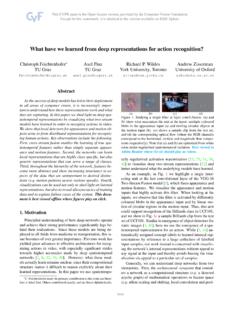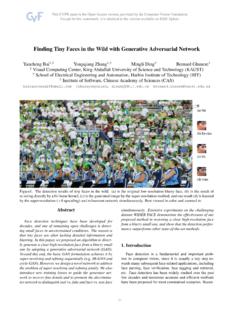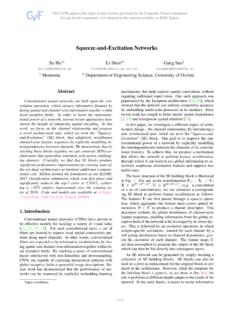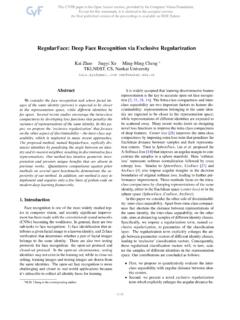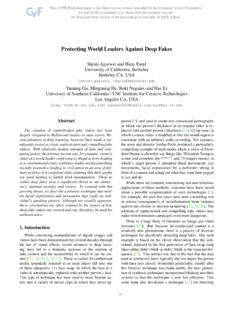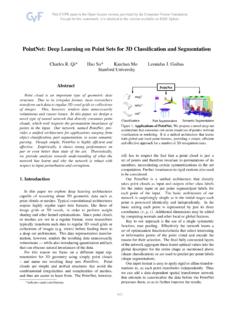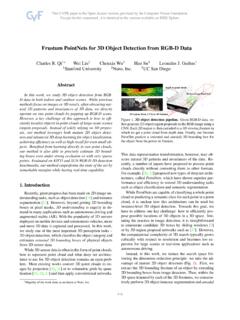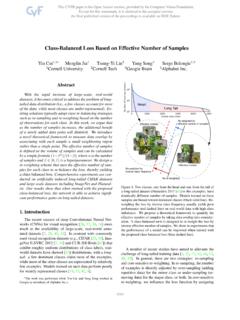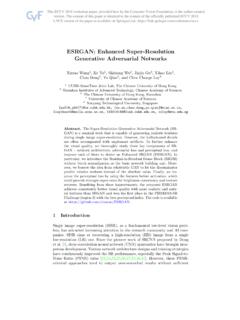Transcription of Encoder-DecoderwithAtrous Separable Convolution for ...
1 Encoder-Decoder with Atrous SeparableConvolution for Semantic Image SegmentationLiang-Chieh Chen, Yukun Zhu, George Papandreou, Florian Schroff, andHartwig AdamGoogle Inc.{lcchen, yukun, gpapan, fschroff, pyramid pooling module or encode-decoder structureare used in deep neural networks for semantic segmentation networks are able to encode multi-scale contextual information byprobing the incoming features with filters or pooling operations at mul-tiple rates and multiple effective fields-of-view, while the latter networkscan capture sharper object boundaries by gradually recovering the spatialinformation. In this work, we propose to combine the advantages fromboth methods. Specifically, our proposed model, DeepLabv3+, extendsDeepLabv3 by adding a simple yet effective decoder module to refine thesegmentation results especially along object boundaries.}
2 We further ex-plore the Xception model and apply the depthwise Separable convolutionto both Atrous spatial pyramid pooling and decoder modules, resultingin a faster and stronger encoder-decoder network. We demonstratethe ef-fectiveness of the proposed model on PASCAL VOC 2012 and Cityscapesdatasets, achieving the test set performance of 89% and withoutany post-processing. Our paper is accompanied with a publicly availablereference implementation of the proposed models in Tensorflow :Semantic image segmentation, spatial pyramid pooling , encoder-decoder, and depthwise Separable IntroductionSemantic segmentation with the goal to assign semantic labels to every pixel in animage [1,2,3,4,5] is one of the fundamental topics in computer vision. Deep con-volutional neural networks [6,7,8,9,10] based on the Fully Convolutional NeuralNetwork [8,11] show striking improvement over systems relying on hand-craftedfeatures [12,13,14,15,16,17] on benchmark tasks.
3 In this work, we consider twotypes of neural networks that use spatial pyramid pooling module [18,19,20] orencoder-decoder structure [21,22] for semantic segmentation, where the formerone captures rich contextual information by pooling features at different resolu-tion while the latter one is able to obtain sharp object order to capture the contextual information at multiple scales, DeepLabv3[23] applies several parallel atrous Convolution with different rates (called Chen, Y. Zhu, G. Papandreou, F. Schroff, and H. AdamImageSpatial pyramid pyramid (a) spatial pyramid pooling (b) Encoder-Decoder(c) Encoder-Decoder with Atrous ConvFig. improve DeepLabv3, which employs the spatial pyramid pooling module (a),with the encoder-decoder structure (b).)
4 The proposed model, DeepLabv3+, containsrich semantic information from the encoder module, while the detailed object bound-aries are recovered by the simple yet effective decoder module. The encoder moduleallows us to extract features at an arbitrary resolution by applyingatrous pyramid pooling , or ASPP), while PSPNet [24] performs pooling opera-tions at different grid scales. Even though rich semantic information isencoded inthe last feature map, detailed information related to object boundariesis missingdue to the pooling or convolutions with striding operations within the networkbackbone. This could be alleviated by applying the atrous Convolution toextractdenser feature maps. However, given the design of state-of-art neural networks[7,9,10,25,26] and limited GPU memory, it is computationally prohibitive to ex-tract output feature maps that are 8, or even 4 times smaller than the inputresolution.
5 Taking ResNet-101 [25] for example, when applying atrous convolu-tion to extract output features that are 16 times smaller than input resolution,features within the last 3 residual blocks (9 layers) have to be dilated. Evenworse,26residual blocks (78layers!) will be affected if output features that are8 times smaller than input are desired. Thus, it is computationally intensive ifdenser output features are extracted for this type of models. On theother hand,encoder-decoder models [21,22] lend themselves to faster computation (since nofeatures are dilated) in the encoder path and gradually recover sharp objectboundaries in the decoder path. Attempting to combine the advantagesfromboth methods, we propose to enrich the encoder module in the encoder-decodernetworks by incorporating the multi-scale contextual particular, our proposed model, called DeepLabv3+, extends DeepLabv3[23] by adding a simple yet effective decoder module to recover theobject bound-aries, as illustrated in The rich semantic information is encoded in theoutput of DeepLabv3, with atrous Convolution allowing one to control the den-sity of the encoder features, depending on the budget of computation , the decoder module allows detailed object boundary by the recent success of depthwise Separable Convolution [27,28,26,29,30]
6 ,we also explore this operation and show improvement in terms of both speed andaccuracy by adapting the Xception model [26], similar to [31], for the task ofDeepLabv3+: Encoder-Decoder with Atrous Separable Convolution3semantic segmentation, and applying the atrous Separable Convolution to boththe ASPP and decoder modules. Finally, we demonstrate the effectiveness of theproposed model on PASCAL VOC 2012 and Cityscapes datasts and attain thetest set performance of and without any post-processing, setting anew summary, our contributions are: We propose a novel encoder-decoder structure which employs DeepLabv3 asa powerful encoder module and a simple yet effective decoder module. In our structure, one can arbitrarily control the resolution of extracted en-coder features by atrous Convolution to trade-off precision and runtime,which is not possible with existing encoder-decoder models.
7 We adapt the Xception model for the segmentation task and apply depthwiseseparable Convolution to both ASPP module and decoder module, resultingin a faster and stronger encoder-decoder network. Our proposed model attains a new state-of-art performance on PASCALVOC 2012 and Cityscapes datasets. We also provide detailed analysis ofdesign choices and model variants. We make our Tensorflow-based implementation of the proposed model pub-licly available Related WorkModels based on Fully Convolutional Networks (FCNs) [8,11] have demonstratedsignificant improvement on several segmentation benchmarks [1,2,3,4,5]. Thereare several model variants proposed to exploit the contextual information forsegmentation [12,13,14,15,16,17,32,33], including those that employ multi-scaleinputs ( , image pyramid ) [34,35,36,37,38,39] or those that adopt probabilisticgraphical models (such as DenseCRF [40] with efficient inference algorithm [41])[42,43,44,37,45,46,47,48,49,50,51,3 9].
8 In this work, we mainly discuss about themodels that use spatial pyramid pooling and encoder-decoder pyramid pooling :Models, such as PSPNet [24] or DeepLab [39,23],perform spatial pyramid pooling [18,19] at several grid scales (including image-level pooling [52]) or apply several parallel atrous Convolution with differentrates (called Atrous spatial pyramid pooling , or ASPP). These models haveshown promising results on several segmentation benchmarks by exploiting themulti-scale :The encoder-decoder networks have been successfullyapplied to many computer vision tasks, including human pose estimation [53], ob-ject detection [54,55,56], and semantic segmentation [11,57,21,22,58,59,60,61,62,63,64].Typic ally, the encoder-decoder networks contain (1) an encoder module thatgradually reduces the feature maps and captures higher semantic information,and (2) a decoder module that gradually recovers the spatial information.
9 Build-ing on top of this idea, we propose to use DeepLabv3 [23] as the encoder moduleand add a simple yet effective decoder module to obtain sharper Chen, Y. Zhu, G. Papandreou, F. Schroff, and H. Adam1x1 Conv3x3 Convrate 63x3 Convrate 123x3 Convrate 18 ImagePooling1x1 Conv1x1 ConvLow-LevelFeaturesUpsampleby 4 Concat3x3 ConvEncoderDecoderAtrous ConvDCNNI magePredictionUpsampleby 4 Fig. proposed DeepLabv3+ extends DeepLabv3 by employing a encoder-decoder structure. The encoder module encodes multi-scale contextual information byapplying atrous Convolution at multiple scales, while the simple yet effective decodermodule refines the segmentation results along object Separable Convolution :Depthwise Separable Convolution [27,28]or group Convolution [7,65], a powerful operation to reduce the computation costand number of parameters while maintaining similar (or slightly better) perfor-mance.
10 This operation has been adopted in many recent neural network designs[66,67,26,29,30,31,68]. In particular, we explore the Xception model [26], similarto [31] for their COCO 2017 detection challenge submission, and show improve-ment in terms of both accuracy and speed for the task of semantic MethodsIn this section, we briefly introduce atrous Convolution [69,70,8,71,42] and depth-wise Separable Convolution [27,28,67,26,29]. We then review DeepLabv3 [23]which is used as our encoder module before discussing the proposeddecodermodule appended to the encoder output. We also present a modifiedXceptionmodel [26,31] which further improves the performance with faster Encoder-Decoder with Atrous ConvolutionAtrous Convolution :Atrous Convolution , a powerful tool that allows us to ex-plicitly control the resolution of features computed by deep convolutional neuralnetworks and adjust filter s field-of-view in order to capture multi-scale informa-tion, generalizes standard Convolution operation.
